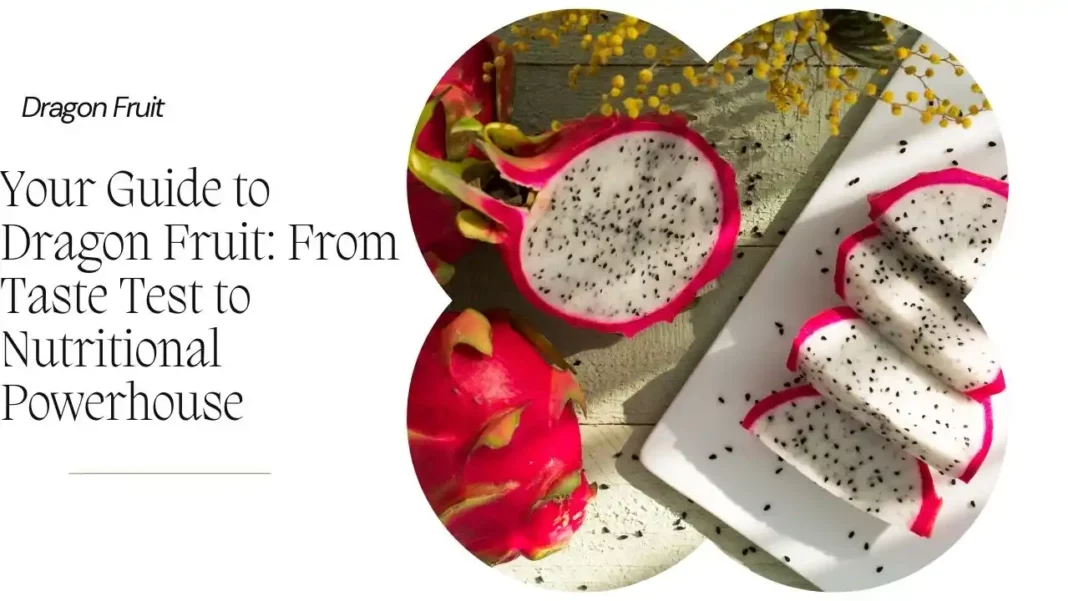The Health Benefits of Dragon Fruit- (2024 Guide)

Are you curious about the mystical allure of dragon fruit and its potential impact on your health? Dive into “Your Guide to Dragon Fruit: From Taste Test to Nutritional Powerhouse,” where we uncover the secrets behind this captivating tropical gem.
This exotic fruit, known for its vibrant appearance and unique taste, holds within its colorful exterior a treasure trove of nutrients that may significantly benefit your well-being. Join us on this flavorful journey as we explore the wonders of dragon fruit, from its delightful taste test to unraveling its status as a nutritional powerhouse.
What is Dragon fruit?

Dragon fruit, also known as pitaya or pitahaya, is a tropical fruit that comes from several species of cactus plants native to Central and South America. It belongs to the genus Hylocereus and Selenicereus and is now also cultivated in other regions with suitable climates, including Southeast Asia and parts of Australia.
The fruit has a distinctive appearance with bright, vibrant skin and a unique shape, usually oval or pear-shaped, with spikes or scales on the outer skin. The most common types of dragon fruit have either red or yellow skin, and the flesh inside is typically white or red, speckled with small black seeds resembling those in kiwi fruit.
Dragon fruit is known for its mildly sweet taste and a texture similar to a cross between a kiwi and a pear, though the flavor can vary depending on the variety and ripeness.
This fruit is prized not only for its appealing appearance but also for its potential health benefits. It’s rich in nutrients such as vitamin C, antioxidants, fiber, and several beneficial minerals, making it a popular choice among health-conscious individuals.
Dragon fruit is versatile and can be eaten fresh, added to smoothies, used in salads, made into juices, or included in various dessert recipes. Its nutritional content and unique appearance have contributed to its popularity as a healthy and exotic fruit option in many parts of the world.
Understanding the Nutritional Profile
| Nutrient | Amount per 100g | Scientific Term |
| Calories | 60 | |
| Protein | 1.2g | |
| Fat | 0.4g | |
| Carbohydrates | 13.8g | |
| Dietary Fiber | 3g | |
| Vitamin C | 9mg | Ascorbic Acid |
| Calcium | 8mg | |
| Iron | 0.7mg | |
| Magnesium | 29mg | |
| Phosphorus | 36mg | |
| Potassium | 229mg |
Health Benefits of Dragon Fruit
- Rich in Antioxidants: Dragon fruit is packed with antioxidants, including vitamin C, which helps combat free radicals in the body. These antioxidants play a role in reducing oxidative stress and inflammation, potentially lowering the risk of chronic diseases.
- Boosts Immune System: The high vitamin C content in dragon fruit can bolster the immune system by supporting the body’s defense against infections and illnesses.
- Promotes Digestive Health: The significant fiber content in dragon fruit aids in promoting a healthy digestive system. Fiber supports regular bowel movements and can help prevent constipation.
- Supports Heart Health: Potassium, found in dragon fruit, is beneficial for heart health. It helps regulate blood pressure and reduce the risk of cardiovascular diseases.
- May Aid in Diabetes Management: The low glycemic index of dragon fruit may be beneficial for individuals managing diabetes. It means the fruit’s sugar is released into the bloodstream slowly, preventing rapid spikes in blood sugar levels.
- Potential Skin Benefits: Some anecdotal evidence suggests that consuming dragon fruit may contribute to healthier skin due to its antioxidants, promoting a youthful appearance and combating signs of aging.
- Hydration and Electrolyte Balance: With its high water content and minerals like potassium, dragon fruit can aid in maintaining proper hydration and electrolyte balance in the body.
- Weight Management: Dragon fruit is relatively low in calories and fat while being high in fiber. This combination can help with satiety and weight management when included as part of a balanced diet.
Taste Test and Culinary Uses
When it comes to the taste of dragon fruit, it offers a subtly sweet and mildly refreshing flavor, reminiscent of a blend between a kiwi and a pear. The texture is often likened to a cross between a kiwi and a watermelon, with black, tiny edible seeds scattered throughout the flesh.
Here are various culinary uses and ways to enjoy dragon fruit:
- Eating Fresh: Simply cut the dragon fruit in half and scoop out the flesh with a spoon. It’s a delightful and refreshing snack on its own.
- Smoothies and Juices: Dragon fruit can be blended into smoothies or juices, adding color, flavor, and nutrients to your beverages. It pairs well with other fruits like mangoes, pineapples, or berries.
- Salads: Dice or slice dragon fruit and add it to fruit salads or green salads for a pop of color and mild sweetness.
- Desserts: Incorporate dragon fruit into desserts like sorbets, puddings, or ice creams. Its vibrant color can make desserts visually appealing.
- Cocktails and Mocktails: Use dragon fruit in cocktails or mocktails for a unique twist. Its vibrant color can create visually stunning drinks.
- Sauces and Salsas: Create sauces or salsas by combining diced dragon fruit with other ingredients like lime, cilantro, and chili for a refreshing and slightly tangy flavor.
- Yogurt or Breakfast Bowls: Add dragon fruit as a topping to yogurt or breakfast bowls for added flavor and texture.
Remember, the versatility of dragon fruit allows for experimentation in the kitchen. Its mild flavor and unique appearance make it an exciting addition to various culinary creations, providing both visual appeal and nutritional value to dishes.
How to Select and Store Dragon Fruit
Selecting and storing dragon fruit properly is crucial to ensure it stays fresh and maintains its quality. Here’s a guide on selecting and storing dragon fruit:
Selecting Dragon Fruit:
- Appearance: Look for dragon fruits with bright, evenly colored skin. The color can vary between red, pink, or yellow, depending on the variety. Avoid fruits with overly brown or withered skin.
- Texture: Gently press the fruit; it should give slightly, similar to ripe kiwi or avocado. Avoid fruits that are too soft or mushy, as they might be overripe.
- Spiky Scales: Check the scales on the fruit. They should be firm and bright. A few browning scales are normal, but excessive browning might indicate aging or poor quality.
Storing Dragon Fruit:
- At Room Temperature: If the dragon fruit is not fully ripe, you can store it at room temperature. It typically takes a few days to ripen. Keep it in a cool, dry place away from direct sunlight.
- In the Refrigerator: Ripe dragon fruit should be stored in the refrigerator. Place it in a plastic bag or container to prevent moisture loss. It can stay fresh for up to five days when refrigerated.
- Avoid Freezing: Dragon fruit does not freeze well, as freezing can alter its texture and flavor. It’s best consumed fresh.
Handling and Preparation:
- Wash Before Consumption: Rinse the fruit thoroughly under running water before cutting into it, even if you don’t plan to eat the skin.
- Peeling or Slicing: To eat, slice the fruit lengthwise, scoop out the flesh with a spoon, or peel the skin away entirely, depending on your preference.
By selecting ripe fruit and storing it correctly, you can enjoy dragon fruit at its best—fresh, flavorful, and full of nutrients. Adjusting storage methods based on the fruit’s ripeness will help extend its shelf life and maintain its quality.
Potential Side Effects or Considerations
While dragon fruit is generally considered safe for most people when consumed in moderation, there are a few potential side effects or considerations to keep in mind:
- Allergic Reactions: Some individuals may have allergic reactions to dragon fruit. Allergies to this fruit are rare, but if you have a known allergy to other tropical fruits like kiwi or pineapple, you might be at a higher risk of being allergic to dragon fruit.
- Gastrointestinal Issues: Eating excessive amounts of dragon fruit, especially for those unaccustomed to its high fiber content, might cause mild gastrointestinal discomfort, such as bloating, gas, or diarrhea.
- High Oxalate Content: Dragon fruit contains oxalates, compounds that may contribute to kidney stones in susceptible individuals. If you have a history of kidney stones, it’s advisable to moderate your intake of high-oxalate foods like dragon fruit.
- Interactions with Medications: Certain medications might interact with components in dragon fruit. For instance, people taking medications affected by potassium levels (such as certain blood pressure medications or potassium-sparing diuretics) should be cautious due to dragon fruit’s potassium content.
- Pesticide Residue: Like other fruits, dragon fruit might have pesticide residues if not organically grown. Washing the fruit thoroughly before consumption can help reduce this risk.
It’s essential to consume dragon fruit in moderation and consider these potential side effects or interactions, especially if you have any underlying health conditions or allergies. Consulting with a healthcare professional or a registered dietitian can provide personalized advice regarding dietary choices and potential interactions with medications or health conditions.
Conclusion
This tropical fruit is a nutritional powerhouse, boasting a significant content of vitamin C, antioxidants, fiber, and essential minerals like potassium. Its diverse nutrient profile suggests various health advantages, including support for the immune system, digestive health, heart health, and potential benefits for individuals managing diabetes.
Moreover, its versatility in the kitchen allows for diverse culinary uses, whether eaten fresh, added to smoothies, incorporated into salads, or used in desserts and beverages.
However, it’s important to consider potential side effects such as allergies, gastrointestinal issues in excessive consumption, and interactions with certain medications. Moderation and awareness of individual sensitivities or health conditions are key when incorporating dragon fruit into your diet.
Overall, integrating dragon fruit into a balanced and diverse diet can contribute to overall health and wellness. Remember, while dragon fruit offers numerous potential benefits, a varied diet rich in a wide array of fruits and vegetables remains the cornerstone of a healthy lifestyle.
Thank you for joining us on this fitness journey! We hope you found our blog insightful and inspiring. Our aim is to provide you with valuable information, expert advice, and motivational content to support you in your wellness endeavors.
Related Post:
- Discover the Top 15+ Surprisingly Filling Foods That Keep You Satisfied Longer
- Apple Cider Vinegar: Benefits, Uses, Dosage, and Risks

Meet Pradeep Singh, your go-to guide for all things fitness, health, and motivation. With over 7 years in the field, Pradeep brings a blend of expertise and real-world experience to his writing. From workout tips to healthy living insights, he simplifies complex topics, making fitness accessible for everyone. His authentic approach and genuine passion aim to inspire and support your wellness journey. Get ready to embark on a path to a healthier lifestyle with Pradeep as your trusted companion and motivator.






















